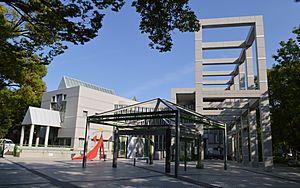Kisho Kurokawa facts for kids
Quick facts for kids
Kisho Kurokawa
|
|
|---|---|
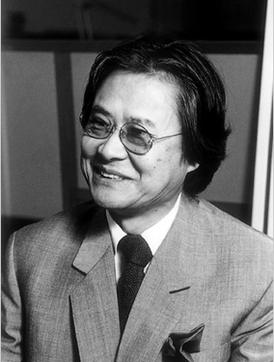 |
|
| Born | 8 April 1934 Kanie, Aichi, Empire of Japan
|
| Died | 12 October 2007 (aged 73) Tokyo, Japan
|
| Alma mater | |
| Occupation | Architect |
| Buildings | Nakagin Capsule Tower, The National Art Center (Tokyo), Nagoya City Art Museum, Kuala Lumpur International Airport |
Kisho Kurokawa (黒川 紀章, Kurokawa Kishō) (April 8, 1934 – October 12, 2007) was a famous Japanese architect. He was one of the people who started the Metabolist Movement. This was a special way of thinking about buildings.
Contents
Kisho Kurokawa's Life Story
Kisho Kurokawa was born in Kanie, Aichi, Japan. He loved architecture and studied it at Kyoto University. He earned his first degree in 1957. Then, he went to the University of Tokyo and got a master's degree in 1959. He even started studying for a doctorate, but he left in 1964. Later, in 2002, he received an honorary doctorate from a university in Malaysia.
In 1960, Kurokawa and some friends started the Metabolist Movement. This was a new and exciting idea in Japanese architecture. The Metabolists believed that buildings should be able to grow and change, just like living things. They wanted to mix and reuse different building styles. This movement became very popular. They were praised for their work at the Osaka World Expo in 1970. The group later ended.
Kurokawa had two children from his first marriage: a daughter named Kako Matsuura, who is a potter, and a son named Mikio, who is a photographer. His second wife was Ayako Wakao, a famous Japanese movie star. Kurokawa's younger brother is also a designer and sometimes worked with him on building projects.
Kisho Kurokawa started his own architecture company in 1962. It was called Kisho Kurokawa Architect & Associates. His main office was in Tokyo, and he had other offices around the world.
In his later years, Kurokawa became very passionate about protecting the environment. He believed in building things that were good for the planet. In 2007, he even ran for governor of Tokyo and for a seat in the Japanese government. He wasn't elected, but he helped start the Green Party to focus on environmental protection. Also in 2007, he helped create the Anaheim University Kisho Kurokawa Green Institute. This institute teaches people how to make businesses more eco-friendly.
Kurokawa wrote many books about his ideas on architecture and life. He also gave many talks. He believed that every culture has visible traditions (things you can see) and invisible traditions (ideas and feelings). He felt his buildings showed the invisible traditions of Japan.
Even though his buildings used modern technology and materials like concrete and steel, Kurokawa believed they still had a Japanese feel. He focused on keeping traditional Japanese ideas hidden in his designs. These ideas included how materials were used, the idea that things don't last forever, being open to new ideas, and paying close attention to small details.
Kisho Kurokawa passed away on October 12, 2007, at the age of 73.
Kisho Kurokawa's Building Ideas
Kurokawa had some very important ideas that shaped his architecture.
Impermanence: Buildings That Change
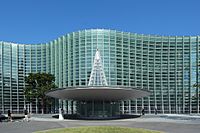
Kurokawa noticed that many Japanese cities were destroyed during World War II. Unlike Western cities built with stone, Japanese cities were often made of wood. This meant they burned down completely. He also knew that Japan often faces natural disasters like earthquakes and typhoons. This constant destruction made Japanese people feel that things don't last forever.
This idea of things not lasting forever, or "impermanence," was important to Kurokawa. He believed buildings should be temporary and able to change. During the Metabolist Movement, his buildings were designed to be moved, swapped, and changed. This made his work like "open systems" that could adapt over time and in different places.
Materiality: Showing True Materials
Kurokawa explained that Japanese people like to show the natural look and feel of building materials. For example, traditional tea rooms were built using natural things like earth, sand, paper, and plants. They avoided artificial colors. This idea of being honest with materials comes from the belief that nature is beautiful on its own.
This idea of "materiality" was clear in Kurokawa's work. He showed iron as iron and aluminum as aluminum. He let the natural look of concrete shine through. In his famous capsule building, he showed all the technology. The capsules, elevators, and pipes were all visible on the outside. Kurokawa believed that each part was beautiful on its own. This bold approach created a unique texture in his buildings.
Receptivity: Being Open to New Ideas
Kurokawa said that Japan is a small country. For a long time, Japan learned from bigger countries like China and later from Western nations. To avoid being taken over, Japan learned from other cultures while still keeping its own identity. This "receptivity," or being open to new ideas, helped Japan grow.
Kurokawa's architecture also showed this openness. At first, his work followed the modern style brought to Japan by other architects. But in the 1960s, Kurokawa and his group started a new kind of Japanese architecture. They felt that simply copying old styles wasn't enough. They called their new approach "metabolism." Kurokawa's work became open to his own ideas about how buildings should be like living things. He often used steel frames and parts that could be changed.
Detail: Caring About the Small Parts
Kurokawa explained that Japanese people pay great attention to small details. This comes from wanting to show skill and individuality. In Japan, things were often built by focusing on the small parts first, then putting them together to make the whole. Every wood connection in a house was carefully made. Even when Japan became an industrial country, the tradition of fine craftsmanship didn't disappear. Japanese makers still care a lot about small details in art, buildings, and products.
Kurokawa's buildings also showed this care for details. He said that paying attention to details was key to understanding his work. He believed that while Western buildings often focused on the big picture first, his Japanese approach focused on the importance of each individual part.
Sustainability: Building for the Future
In 1958, Kisho Kurokawa predicted a shift from the "Age of the Machine" to the "Age of Life." He always used ideas like "metabolism" (meaning to recycle and change), "ecology," and "sustainability" in his work. For 40 years, he created buildings that were good for the environment.
In 2003, he won a big award for designing the Kuala Lumpur International Airport in Malaysia. This airport is special because it's the only one in the world to get a "Green Globe 21" award from the United Nations. This award recognizes its commitment to protecting the environment every year since 2004.
Anaheim University Kisho Kurokawa Green Institute
The Anaheim University Kisho Kurokawa Green Institute was created in his honor in 2008. This institute offers online courses for students to learn about sustainable management. This means learning how to run businesses in a way that helps the environment.
Kisho Kurokawa's Projects
Here are some of the famous buildings Kisho Kurokawa designed:
1970s
- Takara Beautilion, Theme Pavilion, and Toshiba IHI Pavilion, for Expo '70 (Osaka, 1970)
- Nakagin Capsule Tower (Ginza, Tokyo, 1970–1972, demolished 2022)
- Capsule House K, Karuizawa, Japan (1974)
- Sony Tower (Osaka, 1972–1976)
- Tateshina Planetarium (Hiroshima, 1976)
- Headquarters of the Japanese Red Cross Society (Tokyo, 1975–1977)
- National Museum of Ethnology (Osaka, 1973–1977)
- Vitosha New Otani (Sofia, Bulgaria, 1974–1979)
1980s
- Saitama Prefectural Museum of Modern Art (Saitama, 1978–1982)
- National Bunraku Theater (Osaka, 1979–1983)
- Wacoal Kojimachi Building (Tokyo, 1982–1984)
- Chokaso (Tokyo, 1985–1987)
- Nagoya City Art Museum (Nagoya, 1983–1987)
- Japanese-German Center of Berlin (Berlin, 1985–1988)
- Central Plaza 1, Brisbane, Australia
- Osaka Prefectural Government Offices (Osaka, 1988)
- Hiroshima City Museum of Contemporary Art (Hiroshima, 1988–1989)
1990s
- Chinese-Japanese Youth Center (Beijing, 1987–1990)
- Okinawa Prefectural Government Headquarters (Okinawa, 1988–1990)
- The Sporting Club at Illinois Center (Chicago, 1987–1990)
- Melbourne Central (Melbourne, Australia, 1986–1991)
- Miki House New Office Building (Osaka, 1985–1991)
- Nara City Museum of Photography (Nara, 1989–1991)
- Louvain-La-Neuve Museum (Belgium, 1990–1992)
- Pacific Tower (Paris, France, 1988–1992)
- Lane Crawford Place (Singapore, 1990–1993)
- Senkantei (Hyōgo, 1992–1993)
- Ehime Museum of Science (Ehime, 1991–1994)
- Ishibashi Junior High School (Tochigi, 1992–1994)
- The Museum of Modern Art Wakayama/Wakayama Prefectural Museum (Wakayama, 1990–1994)
- Hotel Kyocera (Kagoshima, 1991–1995)
- Kibi-cho City Hall/Kibi Dome (Wakayama, 1993–1995)
- Republic Plaza (Singapore, 1986–1995)
- Fukui City Museum of Art (Fukui, 1993–1996)
- Softopia Japan (Gifu, 1990–1996)
- Fujinomiya Golf Club (Fujinomiya, Shizuoka, 1994–1997)
- Kashima-machi City Hall (Kumamoto, 1995–1997)
- Shiga Kogen Roman Art Museum (Yamanouchi, 1994–1997)
- Kuala Lumpur International Airport (Sepang, Malaysia, 1992–1998)
- New Wing of the Van Gogh Museum (Amsterdam, Netherlands, 1990–1998)
- Amber Hall (Kuji, 1996–1999)
- O Residence (Tokyo, 1997–1999)
2000s
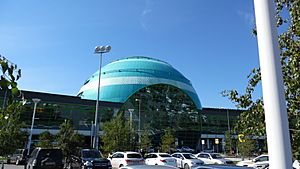
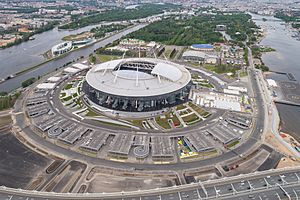
- Fukui Prefectural Dinosaur Museum (Katsuyama, 1996–2000)
- Osaka International Convention Center (Osaka, 1994–2000)
- Oita Stadium (Ōita, 1996–2001, used for the Football World Cup 2002)
- KL Sentral (Kuala Lumpur, 1994-2001)
- Toyota Stadium (Toyota City, 1997–2001)
- Astana International Airport (T2 - Domestic Terminal), (Astana, Kazakhstan, 2000–2003)
- The National Art Center, Tokyo, Roppongi, Tokyo, 2000–2005)
- Campus of Kyushu University (Fukuoka, 2003–2005)
- Singapore Flyer (Singapore, 2005–2008)
- Fusionopolis Phase 1 (Singapore, 2006)
- Zhengzhou International Convention and Exhibition Centre (Zhengzhou, China, 2002–2005)
- Design and Master Plan of Kazakhstan's New Capital (Astana, delayed due to budget problems)
- Krestovsky Stadium (St. Petersburg, 2006–2017)
- Trade Center (Yekaterinburg, 2007)
- Maggie's Cancer Care Centre, Singleton Hospital, Swansea (proposed)
Awards and Honors
Kisho Kurokawa received many awards for his amazing work:
- Gold Medal from the Académie d'Architecture in France (1986)
- Richard Neutra Award (1988)
- Japan's highest award for artists and architects, the 48th Art Academy Award (1992)
- The Art Institute of Chicago renamed a gallery after him, calling it the Kisho Kurokawa Gallery of Architecture (1994)
- Pacific Rim Award from the American Institute of Architects (1997)
- Honorary Doctorate in Humanities from Anaheim University (1998)
- Honorary Fellow of the Royal Institute of British Architects
- Honorary Member of the Union of Architects, Bulgaria
- Honorary Doctorate of Architecture from Universiti Putra Malaysia (2002)
- Dedalo-Minosse International Prize (Grand Prix) for Kuala Lumpur International Airport (2003–2004)
- Green Globe 21 certification from the United Nations for Kuala Lumpur International Airport (2003)
- Walpole Medal of Excellence, United Kingdom (2005)
- Shungdu Friendship Award, China (2005)
- International Architecture Award from The Chicago Athenaeum Museum (2006)
Images for kids
-
New Wing of the Van Gogh Museum in Amsterdam, Netherlands
-
New Wing of the Van Gogh Museum in Amsterdam, Netherlands
See also
 In Spanish: Kishō Kurokawa para niños
In Spanish: Kishō Kurokawa para niños



